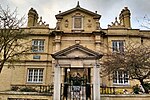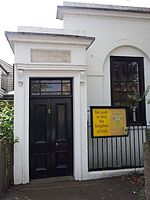The Vineyard, Richmond
EngvarB from July 2018Richmond, LondonStreets in the London Borough of Richmond upon ThamesThe Vineyard, Richmond

The Vineyard is a street in Richmond, in the London Borough of Richmond upon Thames. It includes three groups of almshouses, a Grade II listed church (St Elizabeth of Portugal Church) and Clarence House, a 17th-century Grade II listed house associated with Bernardo O’Higgins, who is commemorated on the wall of the property with a blue plaque, installed by English Heritage, for his role in the Chilean War of Independence.
Excerpt from the Wikipedia article The Vineyard, Richmond (License: CC BY-SA 3.0, Authors, Images).The Vineyard, Richmond
The Vineyard, London St Margarets (London Borough of Richmond upon Thames)
Geographical coordinates (GPS) Address Nearby Places Show on map
Geographical coordinates (GPS)
| Latitude | Longitude |
|---|---|
| N 51.4582 ° | E -0.30181111111111 ° |
Address
The Vineyard 21
TW10 6AQ London, St Margarets (London Borough of Richmond upon Thames)
England, United Kingdom
Open on Google Maps









